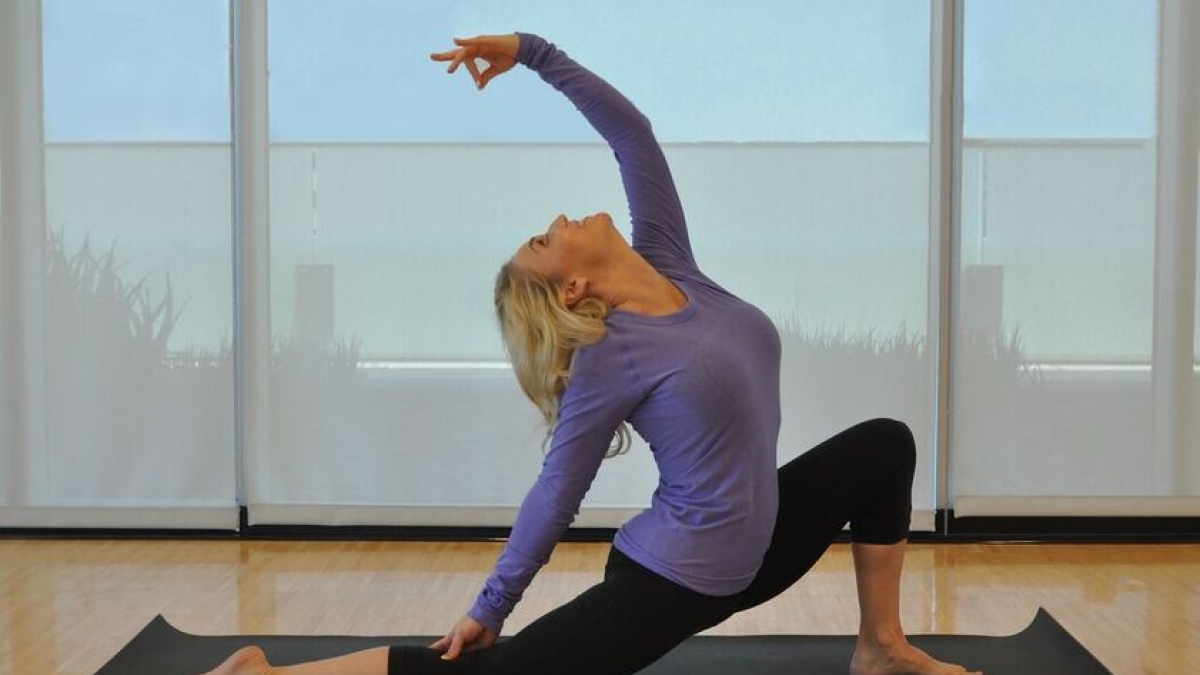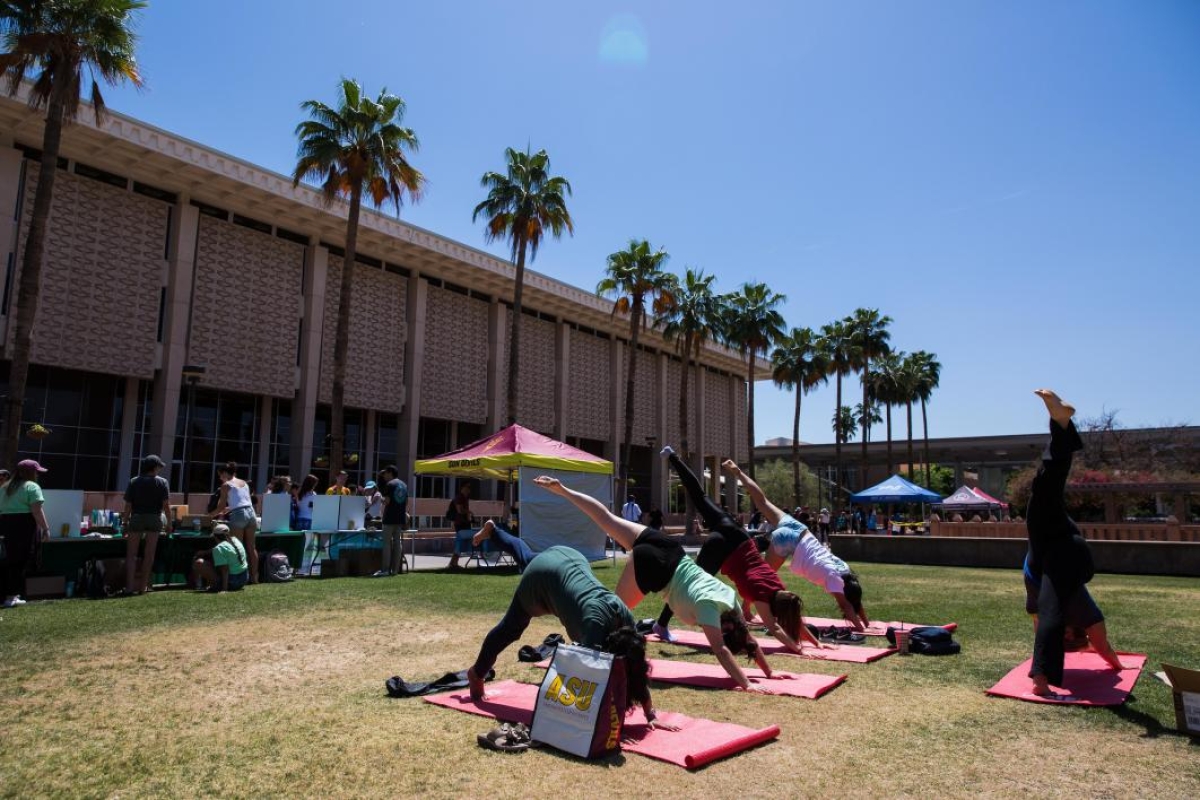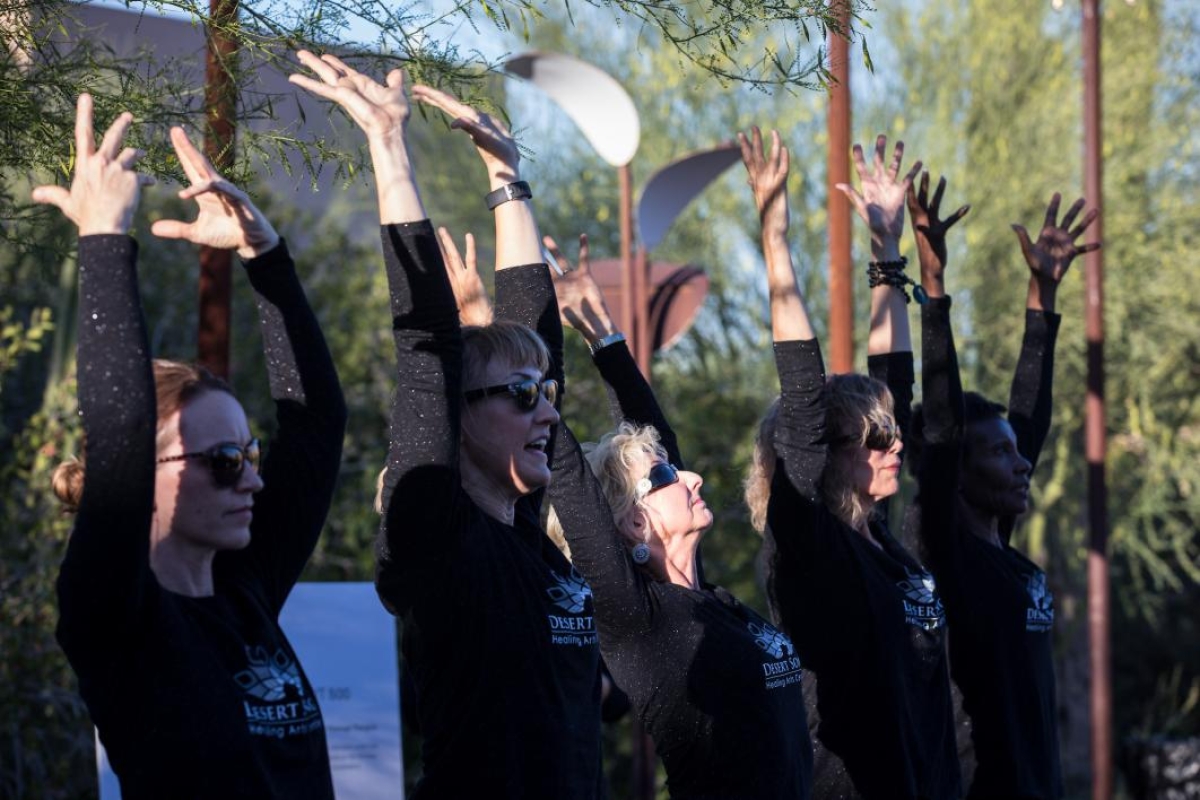Thirty years ago the phrase “downward dog” was likely to raise a few eyebrows when overheard in conversation, but nowadays you’d be hard-pressed to find someone who doesn’t recognize it as a yoga pose.
The United Nations seemed to think so when in 2014 it sought to give the more-than-5,000-year-old practice the recognition it deserved by establishing June 21 as the International Day of Yoga. From 6:30 to 8 p.m. on Saturday, June 17, the Arizona State University student chapter of the Art of Living Foundation will host a community yoga celebration on the Tempe campus’ Hayden Lawn.
The gathering is part of a nationwide event to spread awareness of the practice, and an estimated 50 to 100 people are expected to show up, according to Alicia Nelson, global studies undergraduate and president of the Art of Living ASU student chapter.
Nelson took her first yoga class at ASU a few years ago and began teaching it around the Valley in early 2016.
“Yoga is that time where you say, OK, I’m going to pause everything I’m doing in the outside world and focus on what’s going on inside,” she said. “When you give yourself that time, you’re more aware of how you’re going through life, and it gives you the power to have a deeper experience and come to happiness in the moment.”
Yoga featured prominently at the recent opening of ASU’s Center for Mindfulness, Compassion and Resilience, a new initiative that will bring together researchers, practitioners and educators across disciplines to collaborate, study and spread ideas about mindfulness, compassion and resilience throughout the university and surrounding community.
“I’m really excited about the new center,” ASU health sciences lecturer Julia PearlJulia Pearl is a lecturer in ASU’s School of Nutrition and Health Promotion. She holds the following certifications: E-RYT 500 (Experienced Registered Yoga Teacher); YACEP (Yoga Alliance Certified Education Provider); ACSM-CPT (American College of Sports Medicine, Certified Personal Trainer); and AFAA- CGFI (Aerobics and Fitness Association of America, Certified Group Fitness Instructor). said. She has been teaching yoga since 1995 and hopes to incorporate her specialty, Ashtanga yogaAshtanga yoga is a style of yoga popularized by K. Pattabhi Jois during the 20th century and consisting of eight “limbs,” or branches, of which physical poses are only one. “Power yoga” is a generic term that may refer to any type of aerobically vigorous yoga exercise derived from Ashtanga yoga., into the center’s offerings.
In preparation for Saturday’s event, ASU Now tracked down some of the university’s foremost experts on yoga to create a mini guide on its practice, history and benefits.
Video by Deanna Dent/ASU Now
An age-old practice
The word “yoga” comes from an ancient Sanskrit word that means “to unite,” as in uniting the body, mind and spirit. The practice originated in India more than 5,000 years ago with the goal of enlightenment and self-realization.
“In almost any culture, there’s this desire to understand why are we here, and now that we’re here, how do we live this life,” said attorney and Desert Song Healing Arts Center yoga instructor Alisa Gray. “People have always sought answers to these questions, and we’re still seeking answers.”
Desert Song Healing Arts Center is a community partner of ASU’s Center for Mindfulness, Compassion and Resilience. Gray, who earned her undergraduate and law degree from ASU, also teaches yoga and mindfulness to law students and legal professionals.
Gandhi, as it turns out, was also both a lawyer and a yogi, though not in the sense we might think. He practiced Ahimsa, or non-violence.
“Gandhi was a yogi in the sense of practicing what’s called karma yoga — good works,” Gray said. “So he was a yogi although you wouldn’t see him doing downward dog.”
Western vs. Eastern
Yoga only recently became commonplace in Western countries. Some trace the origin of yoga in the West to the yogi Swami Vivekananda’s visit to the Chicago World’s Fair in 1893, where he demonstrated various poses. Almost a century later, during the 1970s, University of Massachusetts Medical School professor Jon Kabat-Zinn helped boost its popularity in the U.S. when he integrated the teachings with scientific findings.
Since then, yoga has seen the endorsement of celebrities like Sting and Madonna and has even been incorporated into professional athletes’ training regimens.
“Gosh, it’s changed so much over the last 22 years,” Pearl said. “The biggest way is just how mainstream it’s become. … It’s very normalized. Much more so than when I first started in Seattle, when I was involved in the ‘Earthy-mama’ movement.”
And yoga is no longer thought of as a solely religious practice meant to achieve enlightenment.
“Western yoga is definitely more fitness-oriented,” said ASU health sciences lecturer Christina BarthChristina Barth is a lecturer in ASU’s School of Nutrition and Health Promotion. She holds the following certifications: Registered Dietitian Nutritionist; Registered Yoga Teacher., “but it still helps us to manage stress, learn to relax and increase our overall sense of well-being.”
More than just striking a pose
There are several schools of yoga, including Bikram (hot yoga), Yin (slow-paced) and Ashtanga (power). One of the main components of Ashtanga is deep breathing, which Pearl said “almost sounds like Darth Vader” in an otherwise quiet studio.
That breathing aspect is very important, though. In fact, breathing is one of the eight “limbs,” or branches, of yoga. Other limbs include meditation and ethics.
The poses we generally associate with the entirety of yoga actually only make up one limb, called the “asana” limb, and there is some debate among yogis as to where they all came from, since ancient writings mention just one: the seated meditation pose. One theory, according to Gray, is that the plethora of modern-day yoga poses originated from calisthenicsCalisthenics are gymnastic exercises intended to achieve bodily fitness and grace of movement..
There’s also the mental and emotional aspects of yoga to consider, said Devi Davis-StrongDevi Davis-Strong is a lecturer in ASU’s School of Nutrition and Health Promotion. She holds the following certifications: Yoga Alliance 200 Hour Teacher Certification; American College of Sports Medicine Health Fitness Specialist and Personal Training Certificate; American Council on Exercise Group Fitness and Personal Training certifications; Certified Health Education Specialist., ASU exercise science and health promotion lecturer. It’s those aspects, as opposed to the physical poses, that have kept her coming back over the roughly 15 years she has been practicing.
“The poses are challenging, but that’s not really the point of yoga,” Davis-Strong said.
Research to back it up
Among the benefits of yoga are lessened insomnia, anxiety and depression; lower heart, respiratory and blood pressure rates; increased serotonin levels; and improvement in body image. And those benefits have been scientifically proven, something that satisfies Westerners’ desire for empirical justification, Gray said.
Barth, who has been doing yoga for 10 years, has seen firsthand the positive effect it has had on clients at her private practice, who are recovering from eating disorders.
“I’ve seen a big change in them as far as mindful eating,” she said.
Research has also shown that yoga can shift the body from a state of “fight or flight,” our bodies’ natural response to stress, to a more relaxed one.
“We live in such a fast-paced, stressful society, we need a way to calm ourselves, to soothe ourselves,” Davis-Strong said. “The stress response is quick; it’s a survival mechanism” that can muddle the circuitry in our frontal cortex, which helps us make good decisions. “Yoga can help us slow down so we can make better decisions and respond better to challenging situations.”
Anyone can be a yogi
Incorporating yoga into your life could be easier than you thought. Pearl recently helped create a video demonstrating 10 stress-relieving postures that can be done at your desk.
“You don’t even have to go to a gym; you can practice mind-body exercises at your desk when you get an email that makes your blood pressure go up,” she said. “You can do something about it right then that will be better for your well-being.”
When it comes to setting goals, she advises against putting too much pressure on yourself or forcing yourself to do something that’s too difficult.
“With all behavior change, it’s really about starting with the ‘smart’ goals: specific, measurable, attainable, realistic and time-oriented. Things that somebody will actually be able to do, because consistency is key. If you can do five to 10 minutes of yoga a day, that’s better than one, one-and-a-half-hour class a week,” Pearl said.
Adding to that, Davis-Strong said it’s important not to be intimidated and to just enjoy the experience.
“I just encourage people to give it a try and see how they feel,” she said. “Just feel good, have fun and enjoy your body.”
Sun Never Sets on Yoga
What: Yoga session open to the public.
When: 6:30-8 p.m. Saturday, June 17.
Where: Hayden lawn, Tempe campus.
Admission: Free; donations accepted.
Details: Bring mat, water bottle and small meditation cushion. Find more information at ASU Events.
Top photo: ASU health sciences lecturer Julia Pearl does yoga at ASU's Sun Devil Fitness Complex on the Downtown Phoenix campus. Photo by Anna Werner
More Health and medicine

Fighting the fungus among us
It starts with a spore.When inhaled, spores of the coccidioides fungus can cause coccidioidomycosis — better known as valley fever. The spores may be fungi, but they are no fun.Valley fever usually…

$5 million gift to provide scholarships for new ASU medical school students
A $5 million gift from longtime Arizona State University donor Annette Beus and her family will help provide scholarships for 72 students in the new School of Medicine and Advanced Medical…

The science of sibling dynamics: Why we fight, how we relate and why it matters
We have Mother’s Day, Father’s Day and even Grandparents’ Day. But siblings? Usually they get a hand-me-down sweatshirt and, with any luck, a lifetime of inside jokes.But actually, there is a…





